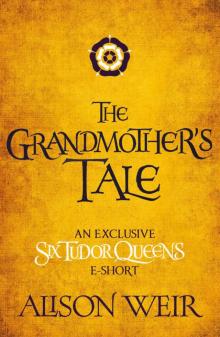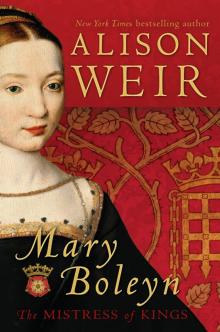- Home
- Alison Weir
The Curse of the Hungerfords
The Curse of the Hungerfords Read online
Copyright © 2019 Alison Weir
The right of Alison Weir to be identified as the Author of the Work has been asserted by her in accordance with the Copyright, Designs and Patents Act 1988.
First published in Great Britain in this Ebook edition in 2019 by
HEADLINE REVIEW
An imprint of HEADLINE PUBLISHING GROUP
Apart from any use permitted under UK copyright law, this publication may only be reproduced, stored, or transmitted, in any form, or by any means, with prior permission in writing of the publishers or, in the case of reprographic production, in accordance with the terms of licences issued by the Copyright Licensing Agency.
All characters – apart from the obvious historical figures – in this publication are fictitious and any resemblance to real persons, living or dead, is purely coincidental.
Cataloguing in Publication Data is available from the British Library
Ebook conversion by Avon DataSet Ltd, Bidford-on-Avon, Warwickshire
eISBN: 978 1 4722 6302 5
HEADLINE PUBLISHING GROUP
An Hachette UK Company
Carmelite House
50 Victoria Embankment
London EC4Y 0DZ
www.headline.co.uk
www.hachette.co.uk
Contents
Title Page
Copyright Page
About Alison Weir
Also by Alison Weir
Praise
About The Curse of the Hungerfords
The Curse of the Hungerfords
Author’s Note
Discover Anna of Kleve
About Alison Weir
Alison Weir is the top-selling female historian (and the fifth-bestselling historian overall) in the United Kingdom, and has sold over 2.7 million books worldwide. She has published eighteen history books, including her most recent non-fiction book, Queens of the Conquest, the first in her England’s Medieval Queens quartet. Alison has also published several historical novels, including Innocent Traitor and The Lady Elizabeth.
Anna of Kleve: Queen of Secrets is Alison Weir’s ninth published novel and the fourth in the Six Tudor Queens series about the wives of Henry VIII, which was launched in 2016 to great critical acclaim. The first three books in the series – Katherine of Aragon: The True Queen, Anne Boleyn: A King’s Obsession and Jane Seymour: The Haunted Queen were all Sunday Times bestsellers.
Alison is a fellow of the Royal Society of Arts and an honorary life patron of Historic Royal Palaces.
Also by Alison Weir
The Six Tudor Queens series
Katherine of Aragon: The True Queen
Anne Boleyn: A King’s Obsession
Jane Seymour: The Haunted Queen
Six Tudor Queens Digital Shorts
Writing a New Story
Arthur: Prince of the Roses
The Blackened Heart
The Tower is Full of Ghosts Today
The Chateau of Briis: A Lesson in Love
The Grandmother’s Tale
The Unhappiest Lady in Christendom
Fiction
Innocent Traitor
The Lady Elizabeth
The Captive Queen
A Dangerous Inheritance
The Marriage Game
Quick Reads
Traitors of the Tower
Non-fiction
Britain’s Royal Families: The Complete Genealogy
The Six Wives of Henry VIII
The Princes in the Tower
Lancaster and York: The Wars of the Roses
Children of England: The Heirs of King Henry VIII 1547–1558
Elizabeth the Queen
Eleanor of Aquitaine
Henry VIII: King and Court
Mary Queen of Scots and the Murder of Lord Darnley
Isabella: She-Wolf of France, Queen of England
Katherine Swynford: The Story of John of Gaunt and His Scandalous Duchess
The Lady in the Tower: The Fall of Anne Boleyn
Mary Boleyn: ‘The Great and Infamous Whore’
Elizabeth of York: The First Tudor Queen
The Lost Tudor Princess
Queens of the Conquest
As co-author
The Ring and the Crown: A History of Royal Weddings, 1066–2011
A Tudor Christmas
Praise
Praise for JANE SEYMOUR: THE HAUNTED QUEEN
‘This six-book series looks likely to become a landmark in historical fiction’ The Times
‘Vivid characters and a wonderful sense of time and place combine with the story of a gentle, kind heroine who I really cared about, the more so because she was so cruelly robbed of her life at the moment of her greatest happiness’ Barbara Erskine
‘Alison Weir gives a fresh take on Jane Seymour’s life . . . A brilliant and engaging read’ Good Housekeeping
‘This brilliant book is a bombshell! Jane Seymour the shy mouse type? Think again! . . . She is vibrant, determined and she sets the King’s court on fire . . . A magnificent novel’ Kate Williams
‘Gripping and utterly compelling . . . Henry VIII’s third and – allegedly – best-loved wife is brought vividly to life . . . Not to be missed’ Tracy Borman
‘Meticulous research is magically transformed into a riveting narrative which takes us into the places non-fiction history cannot reach. It’s what Alison Weir does better than anybody – and what historical fiction was created to do’ Sarah Gristwood
Praise for ANNE BOLEYN: A KING’S OBSESSION
‘This is Anne Boleyn as you have never seen her before. I could not put it down’ Tracy Borman
‘An unforgettable portrait of the ambitious woman whose fate we know all too well, but whose true motivations may surprise you’ Telegraph
‘A triumph of fine detail . . . a complex depiction of an endlessly fascinating woman’ Elizabeth Fremantle
‘The story of Boleyn has been told many times, and from many angles, but this could be the best adaptation so far. A cracking read’ The ady
‘Detailed, immaculately researched and convincing’ The Times
‘Alison Weir’s wonderfully detailed novel offers a spellbinding solution to the mystery of Anne’s true nature . . . At once an enthralling read, and a real contribution to our sense of the sixteenth century’ Sarah Gristwood
‘Anne comes alive and leaps from the page, fascinating, enthralling, full blooded . . . A brilliant evocation of the period . . . Wonderful’ Kate Williams
Praise for KATHERINE OF ARAGON: THE TRUE QUEEN
‘Well researched and engrossing’ Good Housekeeping
‘Weir is excellent on the little details that bring a world to life’ Guardian
‘Alison Weir brings Katherine of Aragon dazzlingly to life . . . A charismatic, indomitable and courageous heroine’ Tracy Borman
‘Yet again, Alison Weir has managed to intertwine profound historical knowledge with huge emotional intelligence, to compose a work that throws light on an endlessly fascinating historical figure. Yet her real gift in all of this is making it feel so fresh and alive’ Charles Spencer
‘Alison Weir is in command of her detail . . . her handling of Katherine’s misery and dignified response to her predicament is very touching’ Daily Mail
‘Weir’s undeniable strength is her immaculate description enabling the reader to be transported back to Tudor England’ Sun
‘A tender understanding of and genuine sympathy for this
proud, much-loved and honourable Queen . . . I was gripped [from] start to finish’ Mavis Cheek
About The Curse of the Hungerfords
A digital short and companion piece to the captivating fourth novel in the Six Tudor Queens series, Anna of Kleve: Queen of Secrets.
Each sunset, as I go to the chapel, I find myself looking for her. I look for details. What she is wearing, some clue to her identity. But she fades away if I look at her directly. I can just glimpse the blur of a hood, or a widow’s wimple, and those sad eyes, staring at something – or someone – I cannot see.
Anne Bassett served four of Henry VIII’s queens, yet the King himself once pledged to serve her. Had fate not decreed otherwise, she might have been his wife – and Queen of England.
But now, far from court and heavy with her husband’s child, Anne prays in the Hungerford chapel, and awaits the ghostly figure she knows will come. This is her story, one that entwines with the fate of another Lady Hungerford from not so many years before. They say there’s a curse on this family . . .
Featuring the first chapter of Anna of Kleve: Queen of Secrets.
Anne Bassett, 1557
Every time I go to Vespers, she is there, standing in the twilight shadows by the chapel door, seemingly oblivious to my presence. A moment later, she is gone. It still chills me to my bones.
Who had she been? I pondered it for a long time. I asked Walter as soon as he was home from court, but his face took on that tight-lipped look I have come to know well, and I knew I would get nothing out of him.
I asked the servants too. They knew nothing. Some regarded me as if I were mad; some looked fearful. Walter said I must not spread such stories. People are superstitious; they will believe anything. When I pressed him to tell me what he thought I had seen, he said it was merely something I had imagined.
I can’t imagine Walter seeing a ghost. He has not the imagination. The famous Knight of Farleigh is a soldier, a sporting man, a practical soul, far more at ease fighting a long battle to get his lands back than with speculation about the supernatural. One skeleton in his closet is enough, and he doesn’t like to talk about that.
I see little of Walter these days, which suits me well. Apart from rare forays home to perform the necessary act of getting me with child, he spends most of his time in London, at Hungerford Inn, his magnificent mansion by the Thames, which is so convenient for the court and Parliament. Earlier this year, he rode north to fight the Scots, and now he is made sheriff of Wiltshire, so I suspect he will be at home more often. We rub along well enough together – and I have as much of his company as I want. But, oh, I do miss the court!
Queen Mary danced at our wedding! I shall never forget it. We had the privilege of being married in her own Chapel Royal at Richmond, and all day the Queen was very pleasant, commanding that everyone join in the mirth and pastime. It had pleased her to be able to offer me, her favourite gentlewoman, to a man whose family had stood up for the Catholic religion – and suffered for it. It was to mark our marriage that she knighted Walter and reversed the Act of Attainder against his father, restoring all his confiscated estates – not to Walter, but to me! He wasn’t at all happy with that, or about having to pay five thousand pounds to buy them back.
Nevertheless, it meant that he was able to bring me here to Somerset; and here I have remained these three years since, bearing his children while he makes his way in the world.
I am praying that this pregnancy will result in a healthy child – a son and heir, if God wills. It’s what Walter wants, more than anything. I married late – I was thirty-three, still comely, people said, yet probably too old to be embarking on motherhood. How my empty arms yearn for my two little girls, each cruelly snatched from me soon after birth. It comforts me to go to the chapel and pray for their souls, knowing that their tiny bodies are at rest in the crypt beneath my feet. And so I see her, every evening.
Maybe I am becoming fanciful in my pregnant state. Each sunset, as I go to the chapel, I find myself looking for her. I look for details. What she is wearing, some clue to her identity. But she fades away if I look at her directly. I can just glimpse the blur of a hood, or a widow’s wimple, and those sad eyes, staring at something – or someone – I cannot see. I have wondered if she has been sent to warn me of some danger, but she seems unaware of my presence. Maybe, as Walter said, she exists only in my head.
Walter comes from an old west country family, the Hungerfords. Farleigh Hungerford is their seat, and lies in the glorious valley of the river Frome, not far from Bath. It’s a peaceful place, for all its stout defences, a pretty, stately castle. As I stand in the inner court, I am in a courtyard house with high towers at each corner, surmounted by conical roofs. There’s a horrible legend attached to one of them. It’s known as the Redcap Tower because of its red roof. But the word redcap has another, more sinister meaning that folks in these parts relish relating. I had not known that a redcap was an evil, bloodthirsty goblin who likes to lurk in ancient buildings.
Our old seamstress told me she’d seen one. ‘Mistress, they be short, squat old men. They have fangs, and claws, and red, fiery eyes! They wear iron boots and red caps, and they carry pikeshafts. They do love to throw stones at unsuspecting humans, and if they kill them, they rinse their cap in the blood.’
I shuddered, but I was sceptical. Such stories are only for the credulous, and I had had the benefit of a French education.
But the old lady was bent on making sure I knew how to protect myself. ‘Mistress, you can drive them redcaps away if you recite Scripture or hold up a crucifix. Then you’ll see ’em yell out and vanish in flames!’
I thanked her for her advice, and went on my way, thinking what nonsense she had spilled forth. And yet, whenever I’ve had occasion since to go up into the Redcap Tower, I make sure I do so in the hours of daylight.
There’s another tower here, the Lady Tower, and the terrible, dark deeds that gave it its name aren’t just silly legends. They really happened, and not that long ago. But I don’t think I could face recounting them now. It might affright the child in my belly. They say unborn babes take fear from their mother.
It’s hard to credit that this peaceful house was the scene of such cruelty and wickedness. People hereabouts say there is a curse on the Hungerfords, that they will be unlucky in their marriages. If that means the pain of losing children, then yes, my marriage has been unlucky. But not as unlucky as my mother-in-law’s.
It is time for prayers. Even though seeing the phantom lady still strikes me with fear, I love the chapel. It contains several tombs of Walter’s ancestors, and the most vivid wall paintings, among which St George looms largest. I never tire of looking at him.
As I make my way there, through the rich rooms of the castle, I can’t help but think – as I always do – of the great tragedy that befell this family. All this, and more, Walter’s father threw away. And for what?
Agnes, 1506–1517
When Agnes married John Cotell of Somerset, she thought she was marrying a gentleman. It never occurred to her to wonder – not at first, anyway – what he was doing in Canterbury. He was well spoken, well dressed and well supplied with money, and he rented a comfortable lodging. He was good to look at too. He seemed never to be idle, and had found a hundred different ways of earning a living. He could turn his hand to anything – buying, selling, supplying; building, painting, repairing; you named it, he could do it.
It upset the town guildsmen of course, for he trespassed on their jealously guarded territory. Therefore some of his work was done after dark, and sometimes after midnight. That prompted a string of complaints from neighbours, angry at having their sleep disturbed by the banging of a hammer, or the unloading of a cart. Agnes was sure they complained to the guilds too, but of course they had no proof that John was stealing work from them. The people who got angrier than most were the Maryons, who lived right next door.
‘Shut that noise!’ Master Robert Maryon would bellow out of his window, driven beyond the need to keep his voice down. ‘Don’t you understand that a man has to be up fresh and alert each morning to do an honest job?’ There was just the slightest stress on the word ‘honest’. Of course, Maryon was a master carpenter by trade. His resentment ran deep.
Then his wife, Kate, would be hammering at the Cotells’ door, nightcap askew, curls tousled, hissing at John to desist and let decent folk sleep! More often than not, the hissing turned to bawling, and then other neighbours would be shouting at her to hush her mouth. Her sister Edith would chime in, and sometimes the arguments got physical – and nasty.
Agnes never knew she had a temper on her till then. The daughter of a wealthy mercer, she had been daintily raised in all the ladylike virtues, in the hope that she would make a good marriage. Her parents still thought she had. They did not know the half of it. For John Cotell’s fists did not rain down exclusively on his irate neighbours; they pummelled his wife whenever he felt she had offended him. And he was an easy man to offend. It did not take long, though, for Agnes to retaliate. Rage and resentment would build in her until she exploded in wrath, lashing out and raining blows on her despicable spouse.
Of course, there were complaints. The Cotells and the Maryons were twice fined for being common scolds, and Agnes was lucky to escape the ducking stool or the bridle. When the exasperated city authorities bound them over to keep the peace, both families were forced to call an uneasy truce, but their anger still simmered.
Three years later, Archbishop Warham carried out a visitation of the clergy and people of Canterbury in St Alphege’s Church. By then, John had been chosen as warden of the fraternity of St John the Baptist at Barham, and become puffed up with self-importance. He was outraged, therefore, when the Archbishop accused him of appropriating forty marks belonging to the brotherhood of St John’s Chapel.
‘I hold no funds belonging to it!’ he protested hotly. ‘I’ll wager I know who made that complaint against me!’ It made no difference. He was ordered to render an account, and spent the evening grumbling as he did so. Agnes kept well out of the way.

 Richard III and the Princes in the Tower
Richard III and the Princes in the Tower Britain's Royal Families: The Complete Genealogy
Britain's Royal Families: The Complete Genealogy The Lady in the Tower: The Fall of Anne Boleyn
The Lady in the Tower: The Fall of Anne Boleyn Six Wives of Henry VIII
Six Wives of Henry VIII Elizabeth of York: A Tudor Queen and Her World
Elizabeth of York: A Tudor Queen and Her World Captive Queen
Captive Queen Innocent Traitor
Innocent Traitor The Marriage Game
The Marriage Game A Dangerous Inheritance
A Dangerous Inheritance Katherine of Aragón: The True Queen
Katherine of Aragón: The True Queen The Marriage Game: A Novel of Queen Elizabeth I
The Marriage Game: A Novel of Queen Elizabeth I Princes in the Tower
Princes in the Tower Anne Boleyn: A King's Obsession
Anne Boleyn: A King's Obsession Traitors of the Tower
Traitors of the Tower Mistress of the Monarchy: The Life of Katherine Swynford, Duchess of Lancaster
Mistress of the Monarchy: The Life of Katherine Swynford, Duchess of Lancaster Queens of the Conquest: England’s Medieval Queens
Queens of the Conquest: England’s Medieval Queens Eleanor of Aquitaine: A Life
Eleanor of Aquitaine: A Life Mary, Queen of Scots, and the Murder of Lord Darnley
Mary, Queen of Scots, and the Murder of Lord Darnley Henry VIII: The King and His Court
Henry VIII: The King and His Court Queen Isabella: Treachery, Adultery, and Murder in Medieval England
Queen Isabella: Treachery, Adultery, and Murder in Medieval England Katheryn Howard, the Scandalous Queen
Katheryn Howard, the Scandalous Queen Arthur- Prince of the Roses
Arthur- Prince of the Roses The Wars of the Roses
The Wars of the Roses Eleanor of Aquitaine: By the Wrath of God, Queen of England
Eleanor of Aquitaine: By the Wrath of God, Queen of England Mary Boleyn: The Great and Infamous Whore
Mary Boleyn: The Great and Infamous Whore Jane Seymour: The Haunted Queen
Jane Seymour: The Haunted Queen Anna of Kleve, the Princess in the Portrait
Anna of Kleve, the Princess in the Portrait Lancaster and York: The Wars of the Roses
Lancaster and York: The Wars of the Roses The Grandmother's Tale
The Grandmother's Tale The Princess of Scotland (Six Tudor Queens #5.5)
The Princess of Scotland (Six Tudor Queens #5.5) The Lady Elizabeth
The Lady Elizabeth Katherine Swynford: The Story of John of Gaunt and His Scandalous Duchess
Katherine Swynford: The Story of John of Gaunt and His Scandalous Duchess The Curse of the Hungerfords
The Curse of the Hungerfords The Lost Tudor Princess: The Life of Lady Margaret Douglas
The Lost Tudor Princess: The Life of Lady Margaret Douglas Eleanor of Aquitaine
Eleanor of Aquitaine Mistress of the Monarchy
Mistress of the Monarchy The Lost Tudor Princess
The Lost Tudor Princess Henry VIII
Henry VIII Anne Boleyn, a King's Obsession
Anne Boleyn, a King's Obsession A Dangerous Inheritance: A Novel of Tudor Rivals and the Secret of the Tower
A Dangerous Inheritance: A Novel of Tudor Rivals and the Secret of the Tower Elizabeth of York
Elizabeth of York Katherine of Aragon, the True Queen
Katherine of Aragon, the True Queen Katherine Swynford
Katherine Swynford Wars of the Roses
Wars of the Roses Queens of the Conquest
Queens of the Conquest Mary Boleyn
Mary Boleyn Britain's Royal Families
Britain's Royal Families The Tower Is Full of Ghosts Today
The Tower Is Full of Ghosts Today Life of Elizabeth I
Life of Elizabeth I Anne Boleyn A King's Obssession
Anne Boleyn A King's Obssession Lancaster and York
Lancaster and York Jane Seymour, the Haunted Queen
Jane Seymour, the Haunted Queen Queen Isabella
Queen Isabella The princes in the tower
The princes in the tower